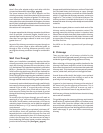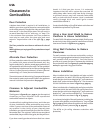4
stove's flue collar adapter and to each other with the
crimped end toward the stove (fig. 2, page 20).
The space between the flue collar adapter and the
chimney connector should be sealed with stove cement
or an appropriately size piece of gasket. This allows any
small amounts of condensed creosote to run into the
stove rather then onto the outside of the pipe or the stove
top. All joints, including the adapter to the flue collar, should
be secured with three sheet metal screws to ensure that
the sections will not separate.
For proper operation the chimney connector should be as
short as possible. Horizontal lengths should have an
upward slope from the stove of 1/4" per foot. Avoid using
more than two 90 degree elbows or total runs of pipe
greater than 1 0'.
No part of the chimney connector may pass through an
attic or roof space, closet or other concealed space, or
through a floor or ceiling. Whenever possible, avoid
passing the chimney connector through a combustible
wall.
Wall Pass-Through
When your installation unavoidably requires that the
chimney connector pass through a combustible wall to
reach the chimney, extreme care must be taken. In the
U.S., the National Fire Protection Association's publication
NFPA 21 1, Standard for Chimneys, Fireplaces, Vents, and
Solid Fuel Burning Appliances, permits four methods for
passing through a combustible wall. In Canada, refer to
CAN/CGA B356. Before beginning the installation, contact
local building officials to make sure the proposed pass-
through method meets local building code requirements.
A commonly used method to pass through a wall directly
to a masonry chimney requires removal of all combustible
material from at least 12" around the entire chimney
connector. The space is then filled with at least 12" of
brick around a fireclay liner. Be sure to locate it so that
the top of the chimney connector will be at least 18" below
the ceiling.
To construct the brick pass-through, you will need an
opening of 30" x 30" minimum. It will be necessary to cut
wall studs, install headers, and construct a sill frame to
maintain proper dimensions and to hold the weight of
the brick. Minimum 3-1/2" (4" nominal) thick solid bricks
are to be used.
The fireclay liner (ASTM C35 or equivalent), minimum 5/8"
wall thickness, must not penetrate into the chimney
beyond the inner surface of the chimney flue liner and
must be firmly cemented in place. If it is necessary to cut
a hole in the chimney liner, use extreme care to keep it
from shattering. Refractory mortar must be used at the
junction to the chimney liner. (See figure 3, page 21)
An approved installation that uses a section of listed solid
fuel insulated factory-built chimney as a pass- through
for the chimney connector, must have an inside diameter
which is 2" larger than the chimney connector- a minimum
length of 12" -and at least 1" of insulation thickness. The
chimney section is installed with at least 2" of air space
between the outer chimney wall and adjacent combustible
materials.
Sheet steel support plates are used on both ends of the
chimney section to keep the connector centred. The
opening around the chimney section is closed on both
sides of the wall with sheet steel plates and the chimney
section is securely fastened to the plates. Fasteners used
to support the chimney section should never penetrate
the inner flue liner.
See NFPA-211 for other approved wall passthrough
methods.
B. Chimneys
There are two types of chimneys suitable for the
Jøtul F 602 USA. An approved masonry chimney, or a listed
residential-type building heating appliance chimney.
When selecting a chimney type and the location for the
chimney in the house, keep this in mind: it is the chimney
that makes the stove work, not the stove that makes the
chimney work. This is because a chimney actually creates
suction, called draft, which pulls air through the stove.
Several factors affect draft: the height, cross-sectional
area, and temperature of the chimney, as well as the
proximity of surrounding trees or buildings.
In general, a short masonry chimney on the exterior of
the house will give the poorest performance. This is
because it can be very difficult to warm up, and in
extremely cold northern areas it may not work at all.
A tall masonry chimney inside the house is easier to keep
warm and will work best.
This guideline gives the necessary chimney requirements
based on the U.S. national code (NFPA-211). However, many
local codes differ from the national code to take into
account climate, altitude, or other factors. It is important
that you check with your local building officials to find out
what codes apply in your area before constructing a
chimney.
USA


















